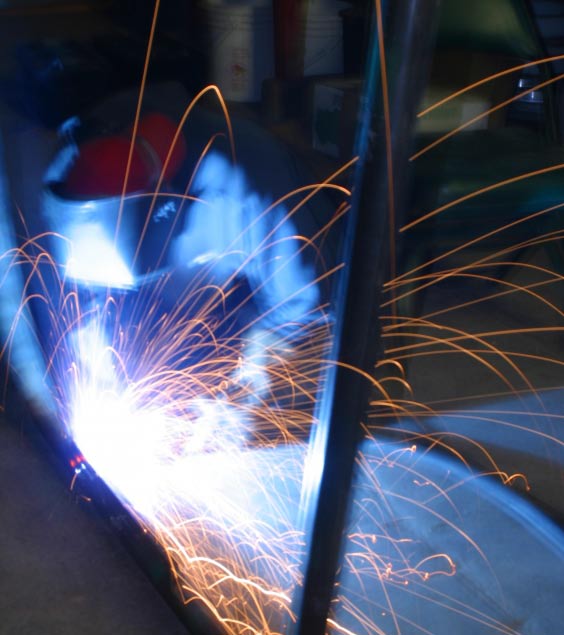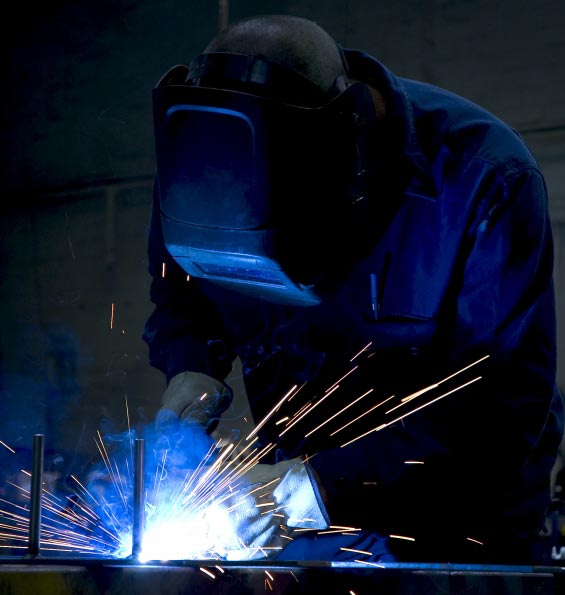JEROME E. SPEAR, CSP, CIH
As with other health hazards, chemicals or agents should be eliminated or controlled at its source, where feasible. In welding, such point source control methods can be categorized as either fume technology-based fume controls or point source fume extraction methods (i.e., local exhaust ventilation). Technology-based fume control methods include the type of welding operation performed, use of process enclosures, and use of automatic or mechanized equipment. Local exhaust ventilation designed specifically for fume control is often referred to as fume extraction systems and may include fixed welding booths/tables with backdraft or downdraft fume extraction systems, portable fume extraction systems, and fume extraction guns. Welding technology, types of ventilation systems, and their role in fume exposure and control is discussed below.
Welding Technology and Fume Control
The primary factor that determines the extent of welding fume exposure is the type of welding operation that is being performed since certain welding processes produce more fume than other techniques. Flux-core arc welding (FCAW) tends to produce more fumes than shielded metal arc welding (SMAW, also know as “stick” welding), and “stick” welding tends to produce more fumes than gas metal arc welding (GMAW). Gas tungsten arc welding and submerged arc welding tend to produce the least amount of fumes. However, selecting welding operations based on the amount of fumes that is generated is often not feasible. For example, when welding heavy or thick material, FCAW is usually the welding process of choice due to its high deposition rate, especially in multiple welding positions. Although gas tungsten arc welding (GTAW) produces little fume, GTAW also has a low deposition rate; therefore, GTAW is limited to precise welding applications. Submerged arc welding (SAW) also produces little fumes but SAW is limited to flat or horizontal applications and is most commonly used with automatic welding applications.
Process enclosures and use of automatic welding equipment may help minimize welding fume exposure by isolating the process from personnel and/or permitting the operator to stay clear of the welding plume. However, depending on the application and welding requirements, enclosures and automatic equipment may not be feasible.

Pulsed arc welding is an alternative welding process used in place of conventional GMAW. Pulse arc welding allows welding to be performed in multiple positions and has been shown to generate fewer fumes than conventional GMAW. However, pulsed arc welding may result in nonfusion when welding on heavy (i.e., thick) material, and therefore, is often not a suitable substitute for FCAW. In addition, pulsed arc welding may still require the use of additional control measures, such as local exhaust ventilation.

Some manufacturers of welding consumables have marketed certain consumables as “low fume welding wire,” claiming a 20% to 77% reduction in welding fumes that are generated. Low welding fume consumables are generally associated with FCAW and the composition of the “low fume welding wire” can affect fume emissions. However, there is no standard or clear definition of “low fume welding wire” composition or performance from the American Welding Society (AWS) or other standards organization. There is also limited field application research available related to “low fume welding wire.”
Local Exhaust Ventilation
General or dilution ventilation may help remove fumes from the building or general work area but has limited affects in reducing welder exposure since the welding plume often travels in the welder’s breathing zone before being extracted from the building or structure. As a result, local exhaust ventilation is more effective than general ventilation methods when attempting in reducing fume exposure to the welder.
Local exhaust ventilation may consist of either a fixed fume extraction with backdraft/downdraft table or both, portable fume extraction system, or an extraction system mounted on the welding gun (i.e., fume extraction guns). There are advantages and limitations with each type of fume extraction system, which are summarized in Table 1, “Local Exhaust Ventilation for Welding Fume Exposure Control.”
Fume Filtration Devices
Another consideration when selecting the fume exhaust system is whether to filter and recirculate the air or exhaust the air to the outside environment. There are several portable and fixed fume filtration devices commercially available and marketed for the welding industry. The portable systems range from briefcase size to refrigerator size, which eliminates the burden of running exhaust hoses out of the building or vessel.
Filtering options include electrostatic precipitators, bag filters, or cartridge-type filters. However, the level of filtration is dependent on the filtering device. Electrostatic precipitators filter by electrically charging collected fume particles and then directing the charged particles through a group of oppositely charged collector plates. Electrostatic precipitators work well on small, submicron particles such as welding fumes. However, electrostatic precipitators cannot handle heavy fume loadings and require frequent maintenance to clean collector plates. If the collector plates are not cleaned, the units lose their filtering efficiency.

Bag filters are a barrier-type filter and are less common than electrostatic precipitators. Bag filters do not filter submicron-sized particles, which limit their use as a fume filtration device. Cartridge-type filters contain a great deal more filter media in a smaller footprint than bag filters and depending on the cartridge, they are also efficient in collecting submicron-sized particles. Cartridge filters allow for easy maintenance but must be cleaned and periodically replaced.
Conclusion
The primary factor in the amount of welding fumes that is generated is the welding process that is used. Controlling welding fume exposure at the source involves both welding technology and local exhaust ventilation considerations. Merely providing supervisors and welders with ventilation equipment will not ensure that they will not be overexposed. Training in ventilation principles and the setup and use of fume exhaust system(s) should be provided to both supervisors and welders.
Local Exhaust Ventilation | Characteristics | Limitations |
Fume Extraction Guns |
|
|
Portable Fume Extraction Systems |
|
|
Fixed Fume Extraction Systems (i.e., Downdraft/Backdraft Tables or Booths) |
|
|

Share This Article!

